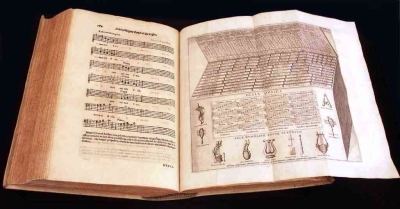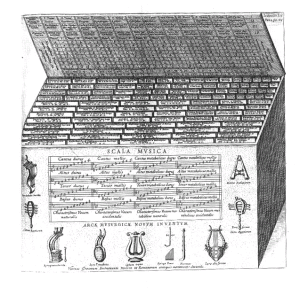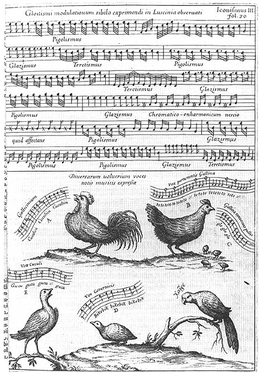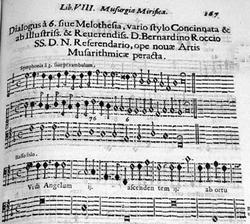Arca
Musurgica

 The "Arca Musurgica", designed in 1650 is a unique device with which a musician or a non-musician can compose music in both contrapuntal and homophonic settings using prearranged musical fragments inscribed on inserts and arranged in columns inside the box. Each type of insert corresponds to a particular metrical unit and on each section there were examples of counterpoint on one side and more simple note settings on the other. There are a few of these devices still in existence.
The "Arca Musurgica", designed in 1650 is a unique device with which a musician or a non-musician can compose music in both contrapuntal and homophonic settings using prearranged musical fragments inscribed on inserts and arranged in columns inside the box. Each type of insert corresponds to a particular metrical unit and on each section there were examples of counterpoint on one side and more simple note settings on the other. There are a few of these devices still in existence.

The Arca Musurgica was described in a publication Musurgia Universalis by Jesuit Father Athanasius Kircher, published in two volumes in Rome in 1650. The book is one of the seminal works of musicology and was hugely influential in the development of Western music – in particular on J.S.Bach (1685-1750) and Beethoven (1770-1827).
Father Kircher lived and worked at the Collegio Romano in Rome for most of his life and his position at the hub of a huge international organization – the 40,000 or so strong Society of Jesus - had two very important effects: first of all he received thousands of letters from Jesuits and others in places as far apart and little-known as China and Mexico, giving him access to unparalleled sources of knowledge mostly unknown to the western world. It was by facilitating a wide diffusion of knowledge, by stimulating thought and discussion by his vast collections of scientific information, that Kircher earned a place among the fathers of modern science and the titles of "universal genius" and "master of a hundred arts".
The following 4 MP3 pieces are transcriptions
that were taken from Musurgia Universalia
If you are interested in working with these unique pieces, you can download the multi-part music notation for all 4 pieces, 4 "MIDI" files (for those of you who have notation programs or audio software that import MIDI),
all 4 MP3s, and both a set of keyboard and
guitar transcriptions (including guitar tablature)
for the price of $4.00.
After your secure payment is processed you will immediately be sent the download links to the email you give while purchasing the collection.
 The
pieces were intended as as programming examples for those who where interested
in learning how to program the automatic organs that Kircher described
in the book. The program was written on paper and then transferred to
a metal cylinder, called cylindrus phonotacticus, that controlled
controlled the instrument. The music was also intended as a demonstration
of the capabilities of automatic instruments, with syncopations and short
note-values. Many historian believe that these pieces may have been composed
with the Arca Musurgica.
The
pieces were intended as as programming examples for those who where interested
in learning how to program the automatic organs that Kircher described
in the book. The program was written on paper and then transferred to
a metal cylinder, called cylindrus phonotacticus, that controlled
controlled the instrument. The music was also intended as a demonstration
of the capabilities of automatic instruments, with syncopations and short
note-values. Many historian believe that these pieces may have been composed
with the Arca Musurgica.
including the music of the spheres, the music of a Renaissance alchemist, music created by software and artificial intelligence, the music of the fairies, the music of the Illuminati, the world's most mysterious book, the world's oldest song, a way you can compose music like Mozart, the world's oldest love song,
and much more........

